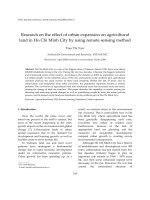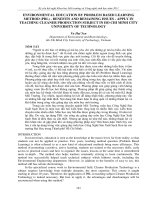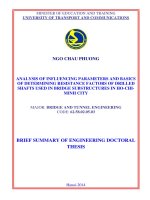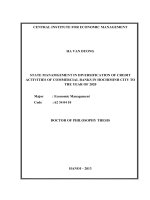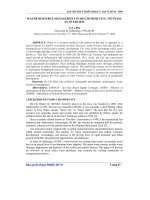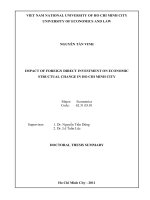Marketing plan for ELF gaz Saigon company in selling LPG as fuel to taxi market in Ho Chi Minh city
Bạn đang xem bản rút gọn của tài liệu. Xem và tải ngay bản đầy đủ của tài liệu tại đây (672.4 KB, 53 trang )
MINISTRY OF EDUCATION & TRAINING
HO CHI MINH CITY OPEN UNIVERSITY
UNIVERSITEÙ LIBRE DE BRUXELLES
SOLVAY BUSINESS SCHOOL
MBMM PROGRAM
TRAN HUU MINH
MARKETING PLAN FOR ELF GAZ SAIGON COMPANY
IN SELLING LPG AS FUEL TO TAXI MARKET
IN HO CHI MINH CITY
FINAL PROJECT
MASTER IN BUSINESS & MARKETING MANAGEMENT
Tutor: Dr. NGUYEN DINH THO
Ho Chi Minh City
2007
WARRANT STATEMENT
This is my original work. Any data, result or quote in the work is clearly
identified.
TRAN HUU MINH
ACKNOWLEDGEMENT
This project is the result of contribution from many concerned organizations and
people. Therefore, I wish to express my gratitude to all concerned people and
organizations for their supports and assistance during preparation of this project.
Firstly, I would like to acknowledge and thank the
Professors, Members,
Coordinators, Classmates of the MBMM program who have delivered valuable
experience, knowledge and assistance during the course.
Secondly, I am grateful to Dr. Nguyen Dinh Tho, who delivers his enthusiastic
assistance, experience, guidance, advice to me during writing this final project.
Finally, I wish to thank my wife and family, who are the great foundation for my
achievement.
TABLE OF CONTENT
Page
EXECUTIVE SUMMARY OF THE FINAL PROJECT
INTRODUCTION OF THE FINAL PROJECT
1
PART 1. ELF GAZ SAIGON COMPANY’S DESCRIPTION
3
1.1. Introduction of ELF GAZ SAIGON Company
3
1.2. The market share of ELF GAZ SAIGON Company
4
1.3. Brief on business situation of ELF GAZ SAIGON Company
5
1.4. Development orientation of ELF GAZ SAIGON
6
PART 2. SITUATIONAL ANALYSIS
7
2.1. Overview of LPG used vehicle situation in Vietnam
7
2.2. Overview of taxi market in Ho Chi Minh city
8
2.3. Overview of Ho Chi Minh city
10
2.4. Environment, Politic, Law and regulations
11
2.5. Opportunities and threats on autogas domain
11
2.6. ELF GAZ SAIGON’s SWOT analysis
12
2.7. Competitors in autogas segment and substitute fuel
13
PART 3. LPG AS FUEL FOR AUTOMOBILES AND ITS BENEFIT
15
3.1. What is LPG
15
3.2. Benefits of LPG
15
3.3. Evolution of Petrol and LPG selling price in 2006
18
PART 4. STRATEGY OF ELF GAZ SAIGON COMPANY
20
4.1. Marketing objective
20
4.2. Marketing strategy
20
4.3. Marketing mix
21
4.4. Implementation
25
4.5. Evaluating methods for the project
26
CONCLUSION AND RECOMMENDATION
28
REFERENCE
APPENDIX
LIST OF APPENDIX
1.
Sales volume of the three sectors of EGS in 2006
2.
Market share of main LPG companies in South Vietnam
3.
Retail selling price evolution of Petrol and LPG in 2006
4.
Guideline used in the in-depth interview
5.
Summary of the in-depth interview
6.
The pricing formula
7.
Illustration of the pricing formula
8.
Explanation of Appendix 6 and 7
9.
Evaluating methods for the project
10.
Explanation of investment cost
11.
Procedure of registration for circulating LPG fuel automobiles
12.
Typical installation of auto – LPG station
13.
Typical installation of auto – LPG station
14.
Types of vehicle tanks put in automobiles
15.
Scheme of bicarburetion equipment
ABBREVIATION
EGS
: ELF GAZ SAI GON Company
LPG
: Liquefied Petroleum Gas
CNG
: Compressed Natural Gas
WTO
: World Trade Organization
HCMC
: Ho Chi Minh city
LIST OF TABLE AND FIGURES
A. TABLE
No
Content
Page
1
The aggregate demand of LPG in Vietnam
4
2
Quantity of LPG used vehicles and LPG dispensing station
7
3
Petrol consumption volume of taxi market per year
8
4
Conversion from Petrol into LPG consumption volume
9
5
Sources of Emission in HCMC
16
6
Comparison between LPG and Gasoline, Diesel on
16
environmental benefit
7
Economical benefit comparison between LPG and Petrol for
17
a taxi/month
8
Cost saving in May, 2007 of taxi market in HCMC if using
17
LPG as fuel
9
Economical benefit comparison on the retail selling price
19
between LPG and Petrol in the whole year 2006
10
Cost saving per km if using LPG as fuel in stead of Petrol
24
B. FIGURES
No
Content
Page
1
Sales volume of EGS for last 05 years
4
2
Retail selling price Evolution of petrol and LPG
18
EXECUTIVE SUMMARY OF THE FINAL PROJECT
ELF GAS SAIGON COMPANY (EGS), founded in 1991, a joint-venture
company, located in HCMC, South Vietnam, specializes in selling gas (LPG)
over the whole country, but mainly, in South Vietnam. It sells gas (LPG) to
domestic sector for cooking and in industrial sector for industrial applications as
ceramics, paint drying, metal smelting, glass, metallurgy etc.
The sales volume growth rate of EGS in some last years is sometimes negative
or unremarkable while the aggregate demand of LPG in Vietnam is more and
more increasing. Therefore, in order to protect and develop the business, EGS
Company must find out and target to some new markets in order to increase its
sales volume and its market share in Vietnam. One of the new and potential
markets in Vietnam in the future is autogas market. It means that EGS sells LPG
as fuel to automobiles market.
The objective of this final project is to make the marketing plan for EGS to
feasibly penetrate in selling LPG as fuel for the first 100 taxi fleet of only one
taxi company in HCMC with the minimum LPG consumption volume committed
by a taxi company in the five year contract term. In order to be successful in this
penetration, EGS has to provide its product with high quality and its package
services as per its different way as follows:
Product
LPG mixture of 70% butane + 30% propane with high quality, ± 10%
molecule (less impurity and low pressure).
Package service
To bear and to loan the whole converting cost for the 100 petrol-used taxis
to dual- fuel taxis (taxis can run both fuels: LPG and Petrol) and the
installation cost for a LPG dispensing station in the taxi Company ‘s garage
with the commitment of the taxi owner for their minimum LPG
consumption volume.
The estimated initial investment of this project is 130,500 USD for converting
100 petrol-fuel taxis to dual fuel taxis (the taxis can run both fuels of Petrol and
LPG) and for installing an appropriate LPG dispensing station placed in a taxi
company’s garage. With estimation, these 100 taxis will consume around 1,683
tons of LPG in the 5 year contract term, occupying 3% of sales volume of EGS
in the whole year 2006.
In order to evaluate this project if it is interesting or not, the author use some
evaluating methods as NPV, IRR, Payback time and Break even sales in unit.
The result are shown below:
Earning after tax
= 12, 245 USD each year except the first year (-5,584)
NPV
= 8,053 USD > 0
IRR
= 10%
Payback period
= 3.8 years
Break even sales
= 870 tons of LPG
> capital opportunity cost (8.5%)
In sum, this project is not only to be the precedent step for penetrating in the
autogas market in HCMC, for increasing the sales volume of EGS but also to
partly participate environmental protection in HCMC in particular and in
Vietnam in general.
-1-
INTRODUCTION OF THE FINAL PROJECT
LPG used as fuel for both automobiles (autogas) and motorbikes is not a new
matter in Vietnam, but unpopular in Vietnam during last time because of some
reasons as lacking LPG distribution network, detailed legal framework, high cost
for conversion and uneasy psychology of people. So, to penetrate into the
autogas market in Vietnam with such current above mentioned conditions is
really difficult. In order to penetrate into this autogas market feasibly, there must
be gradual and appropriate marketing plan and this is the very objective of this
final project.
A. OBJECTIVE
The objective of this final project is to make the marketing plan for EGS to
feasibly penetrate in selling LPG as fuel for the first 100 taxi fleet of only one
taxi company in HCMC with the minimum LPG consumption volume committed
by a taxi company in the five year contract term . In order to be feasible in this
penetration, EGS has to provide its product with high quality and its package
services as per its different way.
B. SCOPE
Period: The project of 05 years from the year 2008 to 2012
Niche : The first 100 taxi fleet of only one taxi company in HCMC.
C. METHODOLOGY
The final project study utilized the following data sources:
Internal data
External data : Secondary and primary data
o Secondary
: Public sources
o Primary
: In-depth interview (See in the Appendix 4)
-2-
D. THE CONTENT
This marketing plan covers four Parts:
Part 1:
ELF GAZ SAIGON Company’s description
This Part describes the company ‘s type, operational scales, business situation
and future orientation. From this data, we find that the reason why EGS needs to
find out some new markets in order to develop and protect its business in the
future. One of the new segment is autogas market for taxi companies in HCMC,
which means that EGS sells LPG as fuel for taxi companies in HCMC.
Part 2:
Situation analysis
This Part covers some aspects concerning external and internal environment
analysis. From these information, EGS can find out possibilities to penetrate in
the potential autogas segment in general and the taxi market in HCMC, in
particular.
Part 3:
LPG as fuel for automobiles and its benefits
This Part mentions the three aspects of LPG, including what is LPG; Benefit of
LPG and the retail selling price evolution of Petrol and LPG last time. These
aspects provide the persuasive evidences concerning economical and
environmental benefit of using LPG as fuel for automobiles in stead of Petrol
and Diesel, which are the essential factors impacting people’s attitude on using
LPG as substitute fuel for petrol and diesel.
Part 4:
Strategy of ELF GAZ SAIGON Company
This Part covers marketing objective, marketing strategy, marketing program,
implementation and control of EGS concerning how to feasibly penetrate into the
taxi market as per EGS’s different way.
-3-
PART 1.
ELF GAZ SAIGON COMPANY’S DESCRIPTION
This Part covers the brief description about EGS ‘s type, operational scale, past,
current business situation and future business development orientation. This
section also mentions the reason why EGS has to find out more new segments for
its business development in the future.
1.1. INTRODUCTION OF FLF GAZ SAIGON COMPANY (EGS)
EGS, a joint-venture company between Total group (France) and HCMC
General Construction Material Company (Vietnam), located at quarter 5, Tan
Thuan Dong ward, Nha Be district, HCMC, Vietnam, founded in 1991, is the first
Company supplying LPG in Vietnam after 1975. EGS operates over the country,
but mainly, in South Vietnam. It supplies LPG in the three sectors:
Domestic (for cooking): Selling LPG contained in 6kg, 12.5kg cylinders to
end users (households).
Semi-industry (for cooking and industrial applications): Selling LPG
contained in 39kg cylinders to small hotels, restaurants, assorted companies
with small LPG consumption volume.
Bulk industry (for industrial applications as ceramics, paint drying,
smelting metal..): Selling LPG to assorted companies with big LPG
consumption volume. There are two sub-segments in bulk industry:
o Traditional segment (exclusive LPG supply): Loaning to the customers
the whole installation including tank, pipeline, vaporizer, primary
regulator and sell LPG exclusively.
o Wholesales segment (unexclusive LPG supply): Selling LPG for those
who possess their own tank systems
-4-
1.2. THE MARKET SHARE OF EGS
1.2.1.
Aggregate demand of LPG in Vietnam
Table 1. The aggregate demand of LPG in Vietnam
Unit: ton
Year
Aggregate demand
2002
2003
2004
2005
20061
500,000
630,000
705,000
830,000
904,000
Source: Hoàng Lộc (23/02/2007), “ Cân nhắc kỹ khi đặt giá mua cổ phần gaz”,
VNeconomy, (htpp://www.vneconomy.vn).
1.2.2.
Sale volume of EGS for last 05 years
Figure 1. Sales volume
Sales volume
48,500
48,000
47,500
(Ton)
47,000
46,500
46,000
45,500
45,000
44,500
44,000
2002
2003
2004
Year
Sales volume (ton)
Source: Internal data
1
Estimated growth rate : 9% per year compared to the year 2005
2005
2006
-5-
1.3. BRIEF ON BUSINESS SITUATION OF EGS
Presently, there are 02 LPG sources providing LPG in Vietnam:
Local LPG source is supplied by Petrovietnam (State-own company).
Imported LPG source is imported from foreign countries.
The supplying capacity of local LPG source occupies around 30% of the
aggregate demand in Vietnam and the remainder must be imported from foreign
countries as Thailand, Malaysia, Singapore etc .
The competition in LPG market among LPG companies is more and more fierce,
both in domestic and industry sectors. Presently, there have been nearly 100
assorted LPG companies operating in Vietnam2. The LPG companies in Vietnam
have to face both competing together to get their market share and preventing
illegal LPG filling of some private LPG filling stations.
The growth rate of EGS is not remarkable compared to that of the market and
compared to that of some main competitors. Some years, the growth rate is
negative . There are some main reasons leading to this situation:
There are more and more new private LPG companies born in Vietnam.
The illegal practices of some private LPG companies.
The price dumping from some LPG companies in the market.
The unfair distribution for the LPG companies from local LPG source.
Not yet to exploit the new potential segments in the market.
The current market share of EGS is around 5.5 % of the aggregate demand of
LPG in Vietnam and around 9% in South Vietnam.
2
Hoàng Lộc (23/02/2007), “ Cân nhắc kỹ khi đặt giá mua cổ phần gaz”, VNeconomy
().
-6-
As shown above, the business growth rate of EGS during last time is sometimes
negative or unremarkable while the aggregate demand of LPG in Vietnam is
more and more increasing. Therefore, in order to protect and stably develop the
business, EGS must have a proper development strategy to increase its sales
volume and market share of the LPG market in Vietnam.
1.4. DEVELOPMENT ORIENTATION OF EGS
In order to protect and develop the business, EGS must have proper development
strategy to increase its sales volume and market share of the LPG market in
Vietnam. One of many ways to protect and develop its business is to re-segment
the market in order to find out the new potential segment3 for its product and
services.
One of the new and potential segments for LPG supply in the future in Vietnam
is selling LPG as fuel for automobile market (autogas market), in which taxi in
HCM is considered as the promising segment. This is the new segment of EGS ‘s
development orientation in the future.
3
Jean Tondeur, “ Market research, Bis & competitive intelligence”, (material course), Solvay Business
School, ULB
-7-
PART 2.
SITUATIONAL ANALYSIS
This Part covers some aspects concerning external and internal environment
analysis as the overview of the trend of LPG-used vehicles in Vietnam; The taxi
market in HCMC; Overview of HCMC; Legal, environment; SWOT, competitors.
From these information, EGS can find out possibilities to penetrate in the
potential autogas segment in general and the taxi market in HCMC, in particular.
2.1. OVERVIEW OF LPG USED VEHICLE SITUATION IN VIETNAM
Presently, the use of LPG as fuel for vehicles has not been popular in Vietnam
during last time. Some of the main reasons are to lack LPG distribution network,
legal framework for the autogas market, high cost for conversion kits etc. It is
proved through the below statistic:
Table 2: Quantity of LPG used vehicles and LPG dispensing station
No
Province in Vietnam
1
Petrol and LPG Petrol
and
LPG Number of LPG
used motorbikes
used automobiles
dispensing station
Ha Noi capital
0
80
02
2
Ho Chi Minh city
0
1204
01
3
Da Nang city
25
0
01
4
Vung Tau city
0
0
01
25
200
05
Total
Source: Nguyen Tu- Dai Duong, htpp://www.tienphongonline.com.vn
: (Vietnamnet online dated 26/08/2006)
4
Son Lam, Sai Gon Giai Phong newspaper, 9/11/2005
-8-
2.2. OVERVIEW OF TAXI MARKET IN HO CHI MINH CITY
2.2.1.
Market size (LPG consumption volume) of taxi market
The traffic density in HCMC is rather heavy with assorted vehicles from
motorcycles, motorbikes, cars , buses to light and heavy trucks etc in order to
satisfy traveling demand for people and to transport goods. Therefore, taxi is one
of indispensable means to satisfy this demand.
The taxi quantity in HCMC in some last years has been remarkably increased
from over 7,000 taxis in 20055 to over 10,000 taxis of 37 assorted taxi companies
operating around HCMC in 2007
6
under the names of Mai Linh (1,400 taxis)7,
Vinasun (over 1,000 taxis)8, Vina Taxi (over 1,000)9, M taxi, Gia Dinh, Deluxes,
Saigon tourist taxi companies etc. Therefore, the petrol consumption volume per
year for such the huge taxi quantity is remarkable. It is shown below:
Table 3. Petrol consumption volume of taxi market per year
Fuel
Petrol
liter/taxi/
liter/taxi
liter/taxi
Taxi
day10
month
year (*)
quantity
20
600
6,600
10,000
Total consumption
(liter/year)
66,000,000
Note: (*) Estimated operation time of a taxi is 11 months/years, 01 month for
maintenance and other reasons.
5
V.H, vnexpress.net , 07/09/2005
Phương Thanh, “ Có chấn chỉnh được taxi dù”, Báo Tuổi Trẻ, thứ Bảy, 10 /03/ 2007
7
Báo Sài Gòn Tiếp Thị online, “Kiểm tra đâu, vi phạm đó”, 20/04/2007
8
Vinasun taxi Company, April, 2007
9
Nguy n Sa,VietNamNet, 11/04/2005
10
Vinasun taxi Company, April, 2007
6
-9-
With the above table, we have the petrol consumption volume per year of 10,000
taxis in HCMC is 66,000,000 liters, which is equivalent to 44,000,000 kg (44,000
tons) of LPG per year through the conversion below.
Table 4. Conversion from Petrol into LPG consumption volume
No
Parameter
Petrol consumption
LPG consumption
1
Unit of measurement
liter
kg
2
Equivalent conversion11
1,5
1
3
Fuel volume/year
66,000,000
44,000,000
2.2.2.
Expectation of taxi companies in HCMC
After in-depth interviews with Managers of the taxi Company12 and taxi drivers
through direct contact and telephone methods to understand their need and
expectation, the author finds that most of the taxi companies and taxi drivers pay
attention to convert fuel from petrol to LPG for taxis with 02 purposes:
Economical and environmental benefits, but they still need to be satisfied
some concerned questions as:
They want to see the actual sample (an automobile) which is already
converted from petrol to both petrol and LPG fuels.
They want to see the actual parameters like economical benefit, operation
of engines through actual test on the converted automobiles.
They want to know how to distribute LPG for their taxis. It means that how
to get LPG for their taxis when fuel is empty.
They want to know who will bear the fuel conversion cost.
The legal formalities is not yet detailed in the autogas domain.
11
12
Internal data
Vinasun taxi Company, April, 2007
- 10 -
With the above mentioned concerns, if satisfying their need and expectation,
EGS has a lot opportunities to succeed in selling LPG to the taxi market in
HCMC.
2.3. OVERVIEW OF HOCHI MINH CITY
HCMC has an area of approximately 2,094 square kilometers and 24 districts
with the population of over eight million inhabitants (permanent and temporary
inhabitant). HCM city is considered as the economic, cultural, industrial center of
the whole country.
The city has looked for and adopted new economic development and
management models to replace the previous subsidy mechanism and become the
country’s largest economic hub. Since 1986, the annual average economic
growth is 10.3 percent. GDP per capita reached VND30 million (equivalent to
US$1,875) in 2006. The city has set targets of achieving an economic growth rate
of between 12.2-12.5 percent, increasing export growth by more than 15 percent
and generating 250,000 jobs in 200713.
So far, 13 industrial and export processing zones in the city have attracted more
than US$2.2 billion in investment capital and generated tens of thousands of
jobs. The city has accelerated the integration process and boost economic growth
to become an industrial, service and scientific-technological centre in Southeast
Asia14.
In sum, with the above mentioned things, HCMC has favorable conditions for
trading business.
13
14
/> />
- 11 -
2.4. ENVIRONMENT, POLITICS, LAW AND REGULATION
Presently, procedures and regulations on fuel conversion, inspection, LPG filling
stations from the State for automobiles are not clear and detailed. Therefore, it is
necessary to set up and bring the detailed regulations on autogas into practices in
the earliest time, which will create good condition for autogas development.
With the integration of Vietnam in WTO, the State step by step will cut down the
subsidization on gasoline selling price. Therefore, the increasing of gasoline
selling price in the coming time is unavoidable. This is proved by the Decision
No:55/2007/ND-CP dated 06 April, 2007 of Vietnamese Prime Minister
concerning gasoline stations who can decide their retail selling price of gasoline
based on market mechanism and under the management of the State15.
Moreover, according to recent Decision No: 17/2007/Q -BGTVT of Ministry of
Communication and Transport in terms of Passenger transport by taxi means
“… Taxi enterprises must have right of land use or land rent agreement for
parking area (minimum parking area for at least one third of taxi quantity and
minimum term of the agreement for 03 year period)…”16. Additionally, to protect
environment protection is one of priority policies of the Vietnamese State in
particular and of the world in general in the 21st century.
2.5. OPPORTUNITIES AND THREATS ON AUTOGAS DOMAIN
2.5.1.
Opportunities
With the above mentioned information, the opportunities for selling LPG to the
taxi segment is realistic through some main factors:
15
16
htpp://www.trade.hochiminhcity.gov.vn
htpp://www.hochiminhcity.gov.vn
- 12 -
The autogas market has been shaped in Vietnam although its development
speed is limited and unpopular.
With the integration of Vietnam in WTO, the increasing of gasoline selling
price in the coming time is unavoidable because the State step by step cut
down the subsidization. Therefore, the local petrol selling price will be based
on the international price. This means that using LPG as fuel for automobiles
is good solution for reducing the fuel cost proved in the Part 3 of this project.
With mentioned LPG consumption volume, the taxi market in HCMC is
considered as the potential and promising market on autogas domain for LPG
companies in the future.
HCMC has favorable conditions for business doing.
Additionally, with the heavy traffic density, environment pollution from
exhaust fumes is the concerned issue in HCMC.
2.5.2.
Threats
The due date of cutting subsidization on the gasoline price is unknown.
Legal formalities on autogas sector is not yet detailed.
Policy of the HCMC authorities on taxi operation in HCMC is unpredictable.
2.6. EGS’ S SWOT ANALYSIS
“ SWOT analysis is a distillation of the findings of the internal and external audit
which draws attention to the critical organizational strengths and weaknesses and
the opportunities and threats facing the company”.17.
17
Page 81, Part 3: Strategic Marketing Planning, Philip Kotler; Gary Armstrong; John Saunders; Veronica
Wong, “Principles of Marketing”, Third European Editor.
- 13 -
Strengths
Trade name in Vietnam is well-known, “foreign company’s trade name”.
Experienced on LPG business in Vietnam for long time
Strong financial, efficiency in business
Well-trained, skilled and experienced staff on LPG business
Supported from the Total group if necessary, one of four LPG companies
belonged to Total group in Vietnam ( development interconnection).
Weaknesses
No gasoline stations available in Vietnam.
Not yet having technical experience on autogas segment.
Opportunity
With the above mentioned concerns of Part 2, it is the right time for EGS to
plan and to deploy the project of selling LPG for this potential taxi market.
Threats
Vietnamese people in general and taxi drivers in particular are not familiar
and not fully aware on effectiveness and efficiency of using LPG for vehicles.
High imported duty rate for LPG converter kits and its accessories.
Regulations of local authorities on taxi operation is unpredictable.
2.7. COMPETITORS IN AUTOGAS SEGMENT AND SUBSTITUTE FUEL
2.7.1.
Main competitors
a. (Saigon) Petrolimex Gas Co., Ltd : Located in HCMC, one of four LPG
selling companies belonged to Petrolimex Gas Joint Stock Company in Vietnam.
Their advantages
To already sell LPG for one available LPG dispensing pump installed and
located in the gasoline filling station of Petrolimex Fuel Company in HCMC.
- 14 -
To have good relationship with Petrolimex Fuel Company which belongs to
the State and possesses 1.500 gasoline stations and its distributor system of
6,000 selling units over the country.18 This is a good condition for them to
associate and to install the LPG dispensing pumps in these gasoline stations.
b. Petrovietnam Gas (PVG): The State-owned company
Their advantages
They both process and trade some local products as LPG, CNG.
The local LPG source supplied to local LPG companies comes from them.
They are decider on local LPG price and the LPG quantity supplied to LPG
trading companies in Vietnam.
They have had the strategy with big scale for developing autogas domain
through two main fuels: LPG and CNG in the whole country, Vietnam19.
2.7.2.
Potential competitors
a. Saigon Petro (LPG): Located in HCMC, belonged to the State
b. Petronas Company : Belonged to Petronas Group in Malaysia
2.7.3.
Threat of substitute fuel: Petrovietnam has planned to build the CNG
station in the suburb of HCM city. CNG is a popular fuel used for automobiles in
the world. It can be a substitute for LPG. 20
In sum, with the above mentioned concerns, the opportunity for EGS to penetrate
into the taxi market (autogas domain) is possible, but how to feasibly penetrate
into this domain is an important question which will be mentioned in the Part 4 of
this project.
18
htpp://www.petrolimex.com.vn.
Leaflet of Petrovietnam gas (Công Ty Chế biến Và Kinh Doanh Các Sản Phẩm Khí)
20
Do Pham Hong Minh, “The situation of autogas/NGV in Vietnam and its trend”
19
- 15 -
PART 3.
LPG AS FUEL FOR AUTOMOBILES AND ITS BENEFIT
This Part covers three aspects of LPG including what is LPG; Benefit of LPG and
the evolution of Petrol and LPG selling price last time. These aspects provide the
persuasive evidences concerning benefit of using LPG as fuel for automobiles in
stead of Petrol and Diesel, which are the essential factors impacting people’s
attitude on using LPG as substitute fuel for petrol and diesel in the coming time.
3.1. WHAT IS LPG
LPG is the abbreviation of Liquefied Petroleum Gas. LPG is a mixture of
hydrocarbons which exists as a vapor under ambient conditions and can be
changed into liquid state by applying moderate pressure. Typical composition:
60-70% butane (C4H10) and 30-40% propane (C3H8). This is the clean and nonpolluted fuel. LPG is used in many domains as cooking, horticultural,
agricultural, heating, drying process, other industrial applications and autogas
(LPG is used as fuel for automobiles).
3.2. BENEFITS OF LPG
3.2.1
LPG is good solution to protect environment
Vietnam becomes the full member of WTO. Therefore, sooner or later, Vietnam
has to comply with the WTO regulations in many domains. One of them is
environment protection corresponding to the worldwide common tendency. LPG
used as fuel for vehicles is one of the best solutions to reduce environment
pollution which is certified by the specialist and worldwide organizations.
The following tables will express the source of emission in HCMC and the
environmental benefit when using LPG as fuel in stead of petrol and diesel.
- 16 -
Table 5. Sources of Emission in HCMC
Pollutants
Industrial
plants
Transport
Living
Others
Total
SO 2
92%
05%
03%
-
100%
NO X
38%
61%
01%
-
100%
CO
15%
84%
01%
-
100%
CO 2
77%
12%
10%
-
100%
HCL
05%
94%
-
01%
100%
Source:Do Pham Hong Minh,“The situation of autogas/NGV in Vietnam and its trend”
Table 6. Comparison between LPG and Gasoline, Diesel on environmental benefit
Compared to Gasoline
Compared to Diesel
75% less Carbon Monoxide
90% less Carbon Monoxide
85% less Hydrocarbons
90% less Hydrocarbons
40% less Nitrogen Oxides
70% less Nitrogen Oxides
87% less ozone forming potential
60% less ozone forming potential
10% less Carbon Dioxide
Source: Seminar, 17th November, 2005, based on tests undertaken by Millbrook
Emissions Laboratories (UK) in 1998 and 1999.
3.2.2.
Economical benefit
As mentioned in 2.4 of Part 2, the Decision No: 55/2007/ND-CP dated 06 April,
2007 of Vietnamese Prime Minister allowing gasoline stations who can decide
their retail selling price of gasoline based on market mechanism and under the
management of the State. This means that step by step the gasoline selling price
in Vietnam will not be subsidized any more. This is a good opportunity for

